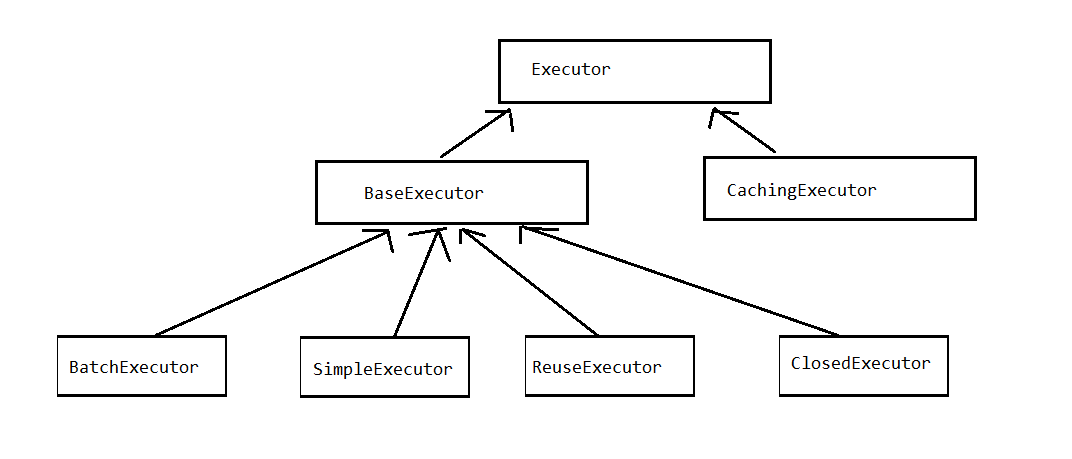Executor介绍
1.Executor介绍:
Executor是mybatis的核心接口之一,其中定义了数据库操作的基本方法,它的子类结构图如下:这这张关系图中,涉及到了模板方法模式和装饰器模式。BaseExecutor是一个抽象父类,定义了一级缓存和事务相关的公共的固定不变的方法,同时定义了doUpdate,doQuery等抽象方法,这些抽象方法是在BaseExecutor的四个子类中实现的。这里用到了模板方法模式。对于CachingExecutor这个类,它为Executor提供了二级缓存的功能,它是一个装饰类,被装饰的目标类是BaseExecutor的四个子类,比如是SimpleExecutor,所以这里用到了装饰器模式。

2.源码分析:
2.1 Executor源码:
public interface Executor {
ResultHandler NO_RESULT_HANDLER = null;
// 执行update,insert,delete三种类型的SQL
int update(MappedStatement ms, Object parameter) throws SQLException;
// 执行select类型的SQL
<E> List<E> query(MappedStatement ms, Object parameter, RowBounds rowBounds, ResultHandler resultHandler, CacheKey cacheKey, BoundSql boundSql) throws SQLException;
<E> List<E> query(MappedStatement ms, Object parameter, RowBounds rowBounds, ResultHandler resultHandler) throws SQLException;
// 批量执行SQL
List<BatchResult> flushStatements() throws SQLException;
// 事务提交
void commit(boolean required) throws SQLException;
// 事务回滚
void rollback(boolean required) throws SQLException;
// 创建一级缓存中使用到的CacheKey对象
CacheKey createCacheKey(MappedStatement ms, Object parameterObject, RowBounds rowBounds, BoundSql boundSql);
boolean isCached(MappedStatement ms, CacheKey key);
// 清空一级缓存
void clearLocalCache();
void deferLoad(MappedStatement ms, MetaObject resultObject, String property, CacheKey key, Class<?> targetType);
// 获取事务对象
Transaction getTransaction();
void close(boolean forceRollback);
boolean isClosed();
void setExecutorWrapper(Executor executor);
}
2.2 BaseExecutor
BaseExecutor是一个实现了Executor的抽象类,它实现了Executor的大部分方法,比如:一级缓存管理和事务管理的基本功能,它的四个子类只需要实现doQuery,doUpdate等抽象方法来完成数据库的相关操作。
public abstract class BaseExecutor implements Executor {
private static final Log log = LogFactory.getLog(BaseExecutor.class);
protected Transaction transaction; // transaction对象
protected Executor wrapper; // 封装的executor对象
protected ConcurrentLinkedQueue<DeferredLoad> deferredLoads;
protected PerpetualCache localCache; // 一级缓存 用于缓存该Executor对象查询结果集映射得到的结果对象
protected PerpetualCache localOutputParameterCache;
protected Configuration configuration;
protected int queryStack = 0;
private boolean closed;
// 获取transaction对象
public Transaction getTransaction() {
if (closed) throw new ExecutorException("Executor was closed.");
return transaction;
}
public int update(MappedStatement ms, Object parameter) throws SQLException {
ErrorContext.instance().resource(ms.getResource()).activity("executing an update").object(ms.getId());
if (closed) throw new ExecutorException("Executor was closed.");
clearLocalCache();
return doUpdate(ms, parameter);
}
// 批量执行多条缓存的SQL
public List<BatchResult> flushStatements(boolean isRollBack) throws SQLException {
if (closed) throw new ExecutorException("Executor was closed.");
return doFlushStatements(isRollBack);
}
public <E> List<E> query(MappedStatement ms, Object parameter, RowBounds rowBounds, ResultHandler resultHandler) throws SQLException {
BoundSql boundSql = ms.getBoundSql(parameter);
CacheKey key = createCacheKey(ms, parameter, rowBounds, boundSql);
return query(ms, parameter, rowBounds, resultHandler, key, boundSql);
}
// 先查询一级缓存,如果未命中,则再查询数据库
@SuppressWarnings("unchecked")
public <E> List<E> query(MappedStatement ms, Object parameter, RowBounds rowBounds, ResultHandler resultHandler, CacheKey key, BoundSql boundSql) throws SQLException {
ErrorContext.instance().resource(ms.getResource()).activity("executing a query").object(ms.getId());
if (closed) throw new ExecutorException("Executor was closed.");
if (queryStack == 0 && ms.isFlushCacheRequired()) {
clearLocalCache();
}
List<E> list;
try {
queryStack++;
list = resultHandler == null ? (List<E>) localCache.getObject(key) : null;
if (list != null) {
handleLocallyCachedOutputParameters(ms, key, parameter, boundSql);
} else {
// 此处会调用在子类中实现的doQuery方法,默认的子类是SimpleExecutor
list = queryFromDatabase(ms, parameter, rowBounds, resultHandler, key, boundSql);
}
} finally {
queryStack--;
}
if (queryStack == 0) {
for (DeferredLoad deferredLoad : deferredLoads) {
deferredLoad.load();
}
deferredLoads.clear(); // issue #601
if (configuration.getLocalCacheScope() == LocalCacheScope.STATEMENT) {
clearLocalCache(); // issue #482
}
}
return list;
}
// 事务提交
public void commit(boolean required) throws SQLException {
if (closed) throw new ExecutorException("Cannot commit, transaction is already closed");
clearLocalCache();
flushStatements();
if (required) {
transaction.commit();
}
}
// 事务回滚
public void rollback(boolean required) throws SQLException {
if (!closed) {
try {
clearLocalCache();
flushStatements(true);
} finally {
if (required) {
transaction.rollback();
}
}
}
}
// 需要在子类中实现的update操作
protected abstract int doUpdate(MappedStatement ms, Object parameter)
throws SQLException;
protected abstract List<BatchResult> doFlushStatements(boolean isRollback)
throws SQLException;
// 需要在子类中实现的query操作
protected abstract <E> List<E> doQuery(MappedStatement ms, Object parameter, RowBounds rowBounds, ResultHandler resultHandler, BoundSql boundSql)
throws SQLException;
}
}
由上面的query方法可知,BaseExecutor提供了一级缓存的查询功能,如果一级缓存未命中,则再会调用在它的子类中实现的doQuery方法,默认的子类是SimpleExecutor。
2.3 SimpleExecutor
SimpleExecutor继承了BaseExecutor抽象类,它是最简单的Executor接口的实现。这里使用到了模板方法模式,一级缓存和事务管理等固定不变的操作封装到了BaseExecutor这个父类中,而update,query等与数据库交互的基本方法,都在子类中实现的。
public class SimpleExecutor extends BaseExecutor {
public SimpleExecutor(Configuration configuration, Transaction transaction) {
super(configuration, transaction);
}
// upate,insert,delete操作
public int doUpdate(MappedStatement ms, Object parameter) throws SQLException {
Statement stmt = null;
try {
Configuration configuration = ms.getConfiguration();
StatementHandler handler = configuration.newStatementHandler(this, ms, parameter, RowBounds.DEFAULT, null, null);
stmt = prepareStatement(handler, ms.getStatementLog());
return handler.update(stmt);
} finally {
closeStatement(stmt);
}
}
// query操作
public <E> List<E> doQuery(MappedStatement ms, Object parameter, RowBounds rowBounds, ResultHandler resultHandler, BoundSql boundSql) throws SQLException {
Statement stmt = null;
try {
Configuration configuration = ms.getConfiguration();
// 创建StatementHandler对象
StatementHandler handler = configuration.newStatementHandler(wrapper, ms, parameter, rowBounds, resultHandler, boundSql);
// 完成Statement的创建和初始化
stmt = prepareStatement(handler, ms.getStatementLog());
// 调用StatementHandler.query方法,执行SQL语句,并通过ResultSetHandler完成结果集的映射
return handler.<E>query(stmt, resultHandler);
} finally {
closeStatement(stmt);
}
}
}
对于另外三个子类这里就不做分析了。接下来介绍CachingExecutor这个类
2.4 CachingExecutor
对于CachingExecutor,通过装饰器模式,为Executor增加了二级缓存的功能,接下来就对它的属性和主要方法做个分析:
2.4.1 属性:
private Executor delegate; // 被装饰的类,也成为目标类
private TransactionalCacheManager tcm = new TransactionalCacheManager(); // 用于管理Cahce和TransactionCache,也就是和二级缓存相关的
2.4.2 查询方法:
public <E> List<E> query(MappedStatement ms, Object parameterObject, RowBounds rowBounds, ResultHandler resultHandler, CacheKey key, BoundSql boundSql)
throws SQLException {
Cache cache = ms.getCache();
// 如果映射配置文件中配置了<cache/>,则此处cache!= null
if (cache != null) {
flushCacheIfRequired(ms);
// 查询节点的useCache配置以及是否是否使用了resultHandler
if (ms.isUseCache() && resultHandler == null) {
ensureNoOutParams(ms, parameterObject, boundSql);
@SuppressWarnings("unchecked")
// 查询二级缓存
List<E> list = (List<E>) tcm.getObject(cache, key);
if (list == null) {
// 如果二级缓存没有查询出结果,会调用封装的Executor对象的query方法,其中会先查询一级缓存,再执行数据库查询操作
list = delegate.<E> query(ms, parameterObject, rowBounds, resultHandler, key, boundSql);
tcm.putObject(cache, key, list); // issue #578. Query must be not synchronized to prevent deadlocks
}
return list;
}
}
// 没有启动二级缓存,直接调用底层Executor执行数据库的查询操作
return delegate.<E> query(ms, parameterObject, rowBounds, resultHandler, key, boundSql);
}
2.4.3 事务提交:
public void commit(boolean required) throws SQLException {
delegate.commit(required); // 调用底层的Executor提交事务
tcm.commit(); // 遍历所有的TransactionCahce对象执行commit方法
}
关于Executor就暂时说这么多吧,其实这些内容在其他文章中都有提到,这里不过是做一个简单的分类总结。
最新文章
- Golang gzip的压缩和解压
- javascript基于原型实现面向对象
- java的文件流:字节流(FileInputStream、FileOutputStream)和字符流(FileReader、FileWriter)。
- TC srm 673 300 div1
- CCNP第三天 EIGRP综合实验
- jquery之each
- 需要知道的开源的框架-IOS
- javascript焦点图(能够自己主动切换 )
- IOS7学习之路二(处理ios6到ios7后UITableView的两个显示问题)
- UI设计学习路线图
- C#打开php链接传参然后接收返回值
- javaWeb学习总结(8)- JSP属性范围(5)
- selenium 设置代理的话,可以使用这种方式,代码是我刚才测试过的,亲测可用
- Linux 安装Python37
- OC基础成员变量、属性变量、实例方法与类方法
- Asp.Net Core 404处理
- java并发编程艺术
- spring aop 获取request、response对象
- jumpserver堡垒机安装
- shell 截取字符串